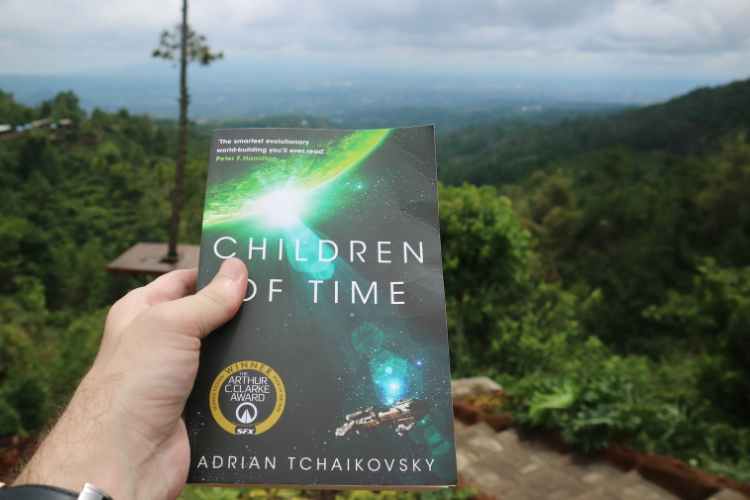The outstanding science fiction book “Children of Time” by Adrian Tchaikovsky transports readers on a magnificent voyage across time, space, and the development of intelligent life. This novel has won praise from critics and enthralled readers all across the world with its provocative ideas, deft world-building, and endearing characters. This review will go into the compelling world of “Children of Time” and examine the factors that have contributed to its status as a modern science fiction classic.
Intriguing Premise and Narrative Structure
The interesting notion of “Children of Time” is one of its best qualities. The story of two different civilizations is told in the novel through a dual narrative. First, after Earth becomes inhospitable, humanity will search for another planet that is habitable. The second story reveals a parallel civilization that is growing in complexity and intelligence as it follows the unexpected emergence of a group of spiders on a terraformed planet.
These two threads are expertly interwoven by Tchaikovsky’s masterful storytelling, yielding an engrossing and thrilling drama. Readers can follow the parallel development and evolution of humans and spiders in the alternate chapters, as well as the significant consequences of their eventual meeting. As the reader turns the pages in anticipation of these two civilizations’ destinies colliding, the narrative structure increases tension and intrigue.
RELATED – EXPLORING THE EPIC JOURNEY: A REVIEW OF “RECORD OF THE MIGHTIEST LORD” CHAPTER 1
Thought-Provoking Exploration of Evolution and Intelligence
A provocative look at intellect and evolution, “Children of Time” poses important concerns regarding the nature of civilization and the viability of interspecies cooperation. Tchaikovsky expertly explores the spider society’s complexity, shedding light on its complicated social structures, communication networks, and cultural evolution. The novel questions established ideas of intelligence and illuminate the possibility that intelligence may manifest itself in unexpected and varied forms through the prism of the development of spiders. The author skillfully examines the development of sentience as well as the difficulties both humans and spiders have when navigating the complexity of their own surroundings.
The relatable and nuanced characters give the story depth by enabling readers to relate to their motivations, foibles, and personal development. In particular, the spider characters invite readers to reconsider their previous notions about intellect and civilisation. The science fiction novel “Children of Time” explores complex issues like the nature of mankind, evolution, and the prospect for cooperation. It is a thought-provoking and compelling read. Tchaikovsky’s eloquent storytelling skills and in-depth knowledge of science and psychology produce a narrative that inspires reflection and leaves a deep impression on readers.
Rich and detailed World-building
The world that Tchaikovsky creates in “Children of Time” is superb, engrossing readers in a full and intricate realm. The terraformed planet is wonderfully shown, inspiring awe and intrigue with its distinctive ecology and developing spider civilization. The author’s focus on scientific details and the interaction between the environment and emerging organisms give the story depth and realism.
Additionally, Tchaikovsky’s examination of human society on board the generation ship offers a window into the difficulties and battles of a civilization on the verge of annihilation. The tale gains levels of complexity through the depiction of humanity’s search for a new home, societal conflicts, and the moral choices the protagonists must make, which makes it realistic and thought-provoking.
Complex and Sympathetic Characters
The characters in “Children of Time” are richly detailed and present readers with a wide variety of viewpoints. Each character is well-rounded and interesting, from the determined scientist Devi and the sympathetic ship AI, Kern, to the crafty and resourceful Portia, the head of the spider civilisation. The author deftly examines the characters’ motivations, foibles, and evolution throughout the narrative, making them realistic and arousing readers’ sympathies.
Additionally, Tchaikovsky’s investigation of the spider society disproves stereotypes and preconceptions while emphasizing the complexity of intelligence and civilization. The characters in the spider stories are given depth and nuance, which forces readers to reconsider their preconceptions of other species.
RELATED – HOW TO GET FREE ROBUX – IS IT WORTHY?
Conclusion
In conclusion, “Children of Time” by Adrian Tchaikovsky is a remarkable science fiction novel that captivates readers with its intriguing premise, thought-provoking exploration of evolution and intelligence, rich world-building, and complex characters. Tchaikovsky’s skillful storytelling and narrative structure draw readers into a fascinating dual narrative, as humanity’s quest for survival and the unexpected evolution of spiders on a terraformed planet converge. The novel’s exploration of evolution and intelligence challenges conventional notions, highlighting the potential for diverse forms of sentience to arise. Tchaikovsky’s vivid world-building immerses readers in a richly detailed universe, from the terraformed planet with its unique ecology to the intricate spider society, fostering a sense of wonder and fascination.
